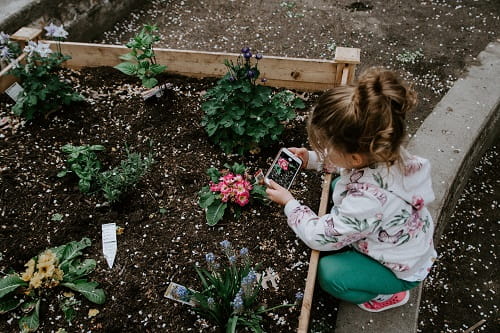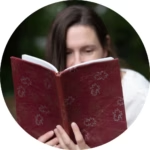Creating a pollinator garden at home connects children to nature and gives them an opportunity to observe the insects we rely on for over 1,200 fruit and vegetable crops. If this is your first gardening experience with your child, start simple. The garden can be large or small. It doesn’t matter. You can even create a “garden” in containers on a patio or veranda. The flowers will attract butterflies, moths, bees, and other pollinators. Be prepared for the unexpected. In the “real” vs. virtual world what we plan is not always what we get. Either way the pollinators will appreciate the fresh flowers and your child will develop academic and life skills.
Benefits of Gardening with Children
Gardening with children offers them physical, academic, and emotional satisfaction and enjoyment. Physically, gardening is good exercise and offers a pleasant way for children to refine their fine motor skills. Gardening is a full sensory immersion in touch, sound, sight, and sometimes even taste. In addition, gardening is a calming activity that releases anxiety for both children and adults. Academically, gardening offers children an opportunity to experience hands-on math, including measurement, basic arithmetic, and pattern recognition. Science learning includes botany, food science, environmentalism, and ecology where predicting outcomes is a key scientific concept to master. Perhaps, most importantly, children who engage in gardening learn responsibility and stewardship. Watching a parent role model acceptance, understanding, and resilience in the garden teaches a child how to develop these important life skills. Practicing patience will help your child expand this major life skill so that they can apply it to other situations and problems.
How To Be Pollinator Friendly
A pollinator garden is a year-round habitat vs. a flower garden which only offers nectar/pollen for insects in the summer or a vegetable garden which is often sprayed with chemicals and left bare in winter. In a pollinator garden, fallen leaves and dead flower stems are not cut down as they offer cover for pollinators in winter. Only monarch butterflies migrate to warmer climates while other pollinators, including queen bumble bees, need autumn leaves on the ground to hide. Best practice in pollinator gardens include:
- No weed killers, pesticides, herbicides, or fertilizers
This includes both chemicals you spray and lawn services that spread granules of “fertilizer” which contain pesticides. While the E.U. is banning these pollinator killing chemicals, the U.S. has not thus far. These cancer-causing chemicals pollute our drinking water and have even been found in the Arctic. Plants we call “weeds” and insects we call “pests” are important food sources in the food chain. Try hand weeding, which is great for building hand strength and your child’s fine motor control. Look to natural pest agents like ladybugs or praying mantises for pest control. Note that spraying an entire yard for mosquitoes also kills pollinators and is not effective for eliminating adult mosquitoes. Keep your yard free of standing water and empty old buckets or tires to rid your garden of potential mosquito breeding areas (read more here). - Keep fallen leaves under shrubs and trees
Most butterfly and moth larvae need fallen leaves to nest in the summer and over winter during the cold months. Other butterflies and moths spend their winters in chrysalides or cocoons so they need branches to hang from. Meanwhile, many solitary native bees curl up in the hollow of a dead flower stem. A “neat” garden means no pollinators. Adopt an aesthetic that is wilder and gives pollinators year-round habitat. - Plant both host plants and nectar plants
Butterflies and moths require specific plants to lay eggs on. Monarchs, the most famous pollinator, need milkweed. Connect with the North American Butterfly Association and your local chapter of the North American Native Plant Society. Both organizations will list which flowers to plant and where. - Let your lawn go natural
Americans use 10x more pesticides on their lawns than farmers. These chemicals are often hidden in fertilizers and even coated around grass seeds. Let go of the lawn aesthetic which was historically used to show wealth. Consider planting a no-mow lawn, expand your garden area, employ the mosaic mowing technique, or simply allow violets, clover, and dandelions to sprout (all of which pollinators use as food). - Leave up old trees (snags)
Old or dead trees offer excellent nesting and over wintering areas for pollinators. Cut old tall trees down to 6 feet to give pollinators habitat and support bird populations.
Create the Garden Bed
- Prepare the area
How difficult or easy this first step is will depend on your garden’s soil type and vegetation. If this is your first garden, start small, maybe even a thin border bed alongside the house or fence. Hand weed as much as possible and dig soil over to shake out weed roots. Mix in a bag of organic compost or garden soil, which is especially needed for hard, dense dirt. - Selecting plants
Select flowers native to your area by checking in with your local chapter of the North American Native Plant Society. These will be perennial plants that come back year after year. Check the soil, water, and light conditions needed for the flower and decide if your garden meets those conditions. Prepare yourself and your child for the possibility the plant may not take well. Learning which plants will thrive in your garden takes practice, patience, and time. - Planting your flowers
Mulch does not support pollinators. Instead, plant flowers close together for a cottage garden look where the flowers outcompete any unwanted weeds. Or fill in empty spaces with annual flowers (plants that die off in winter). Note, the first few weeks into the growing season some hand weeding will be necessary until all the flowers grow big enough. Some weed sprouts will not hurt the other plants. Also, if you want to support a particular butterfly or moth plant a lot of their host plant. Hungry caterpillars will strip host plants of leaves if all the eggs hatch. For instance, if you want to support monarch butterflies, plant an entire bed of milkweed. Your child will delight in observing caterpillars transform into butterflies and the milkweed will grow back next year if the plants are denuded. - Watering
Depending on your location, you may have to water every day. Again, if this is your first garden start small so caring for the garden does not become overwhelming. If you have a container garden on your veranda or patio, those flowers might need watering twice a day as plants in containers dry out faster than ones planted in the ground. - Preparing for winter
With your child look for chrysalides hanging from old flower stems and branches. Many blend-in well as a defense against predators so do not be discouraged if you do not spot any. You won’t know what you have until next summer! Let fallen leaves remain on top of the garden bed through spring. There’s no need to do any cleanup. As spring returns, track night temperatures. When your area has had ten nights with temperatures at 50 degrees Fahrenheit or above, pollinators will have had enough time to wake up from the cold winter months. You can begin to remove leaves if desired, but ultimately it is better for pollinators to allow leaves to stay on the ground. Flowers grow up through fallen leaves, the leaves decompose into nutrients for the soil, and it is a great lesson in the cycle of life for your child.
What to Plant
Check with the local chapters of both the North American Native Plant Society and North American Butterfly Association for more plant suggestions for your area. Purchase plants from native plant nurseries not big box stores where flowers are often sprayed with poisonous chemicals.
Perennials
(Come back year after year, best if purchased as potted plants or plugs)
- Milkweed: There are over 73 species of this monarch supporting plant. Check with your chapter of the North American Native Plant Society to find out where you can purchase local plants. These are deer resistant.
- Beebalm: Excellent nectar flower that attracts butterflies, bees, and hummingbirds. These are also deer resistant.
- Coneflower: Favorite food source for most pollinators, but not deer resistant. Beware the double or triple pompom varieties of this flower as they do not offer any pollen/nectar for pollinators.
- Goldenrod: Autumn blooming perennial often mistakenly accused of causing hay fever. (Ragweed with small green flowers causes hay fever.) This plant is an important pollen/nectar source and a host plant as well. Many varieties are deer resistant.
- Asters: Autumn blooming perennial famous for its purple flowers. There are over 100 species of aster in North America. They are all pollen/nectar sources for pollinators and host plant to many butterflies and moths. They are not deer resistant.
Annuals
(Annuals bloom one season and can be raised by seed or purchased as seedlings. Growing from seed take practice. Be sure to check seed packet to confirm seeds have not been pretreated with chemicals.)
- Zinnias: Favorite of butterflies and bumble bees. Leave dried out, dead flower heads to attract goldfinches and other seed-eating birds. Beware the pompom varieties as their pollen/nectar is not accessible to insects. These are deer resistant.
- Nicotiana: Tall spikes of flowers in varying colors. Favorite of moths, butterflies, and hummingbirds. These are deer resistant.
- Cleome: Tall, wispy flowers also called Spider Flower. Attracts butterflies, moths, bees, and hummingbirds. These are deer resistant.
- Salvia: The Victoria Blue variety is a favorite among bumble bees and the red varieties attract hummingbirds. Do not buy the traditional home and garden salvia, Salvia splendens, as it does not attract pollinators. These are deer resistant.
Gardening with your child has numerous benefits for everyone from learning life skills to contributing to a healthier environment. Start small, be patient, and enjoy nurturing your child and connecting with nature.
More Resources
- “Gardening for Pollinators,” US Forest Service
- “Ecoregional Planting Guides,” Pollinator Partnership
- The Xerces Society


